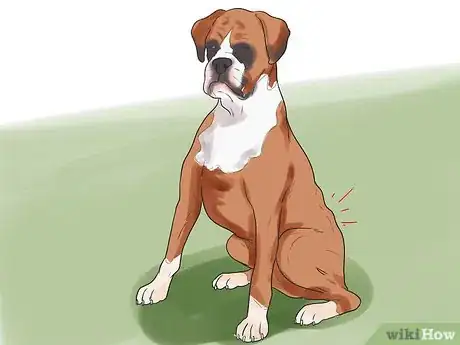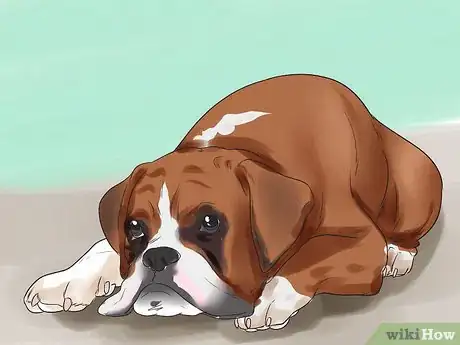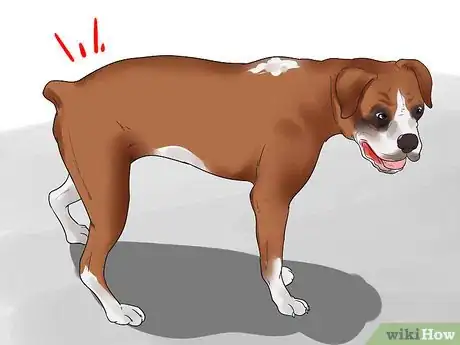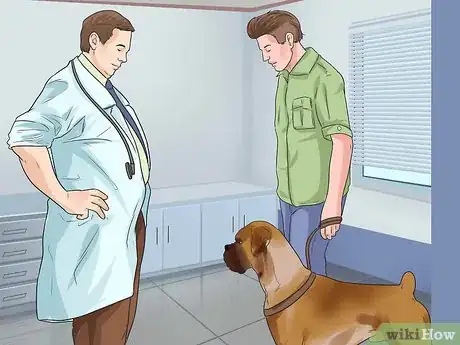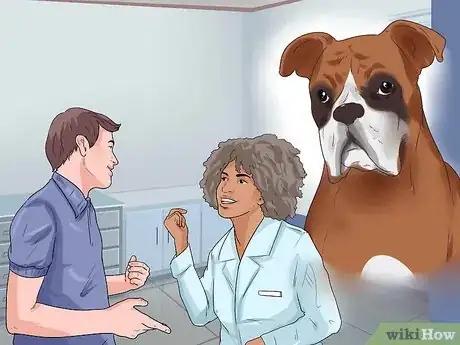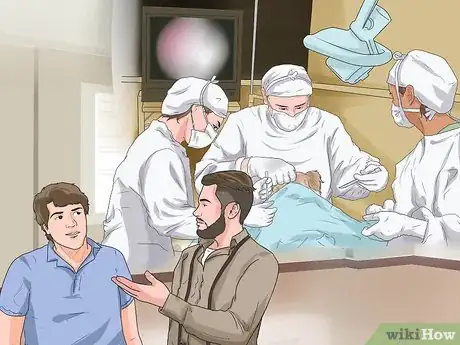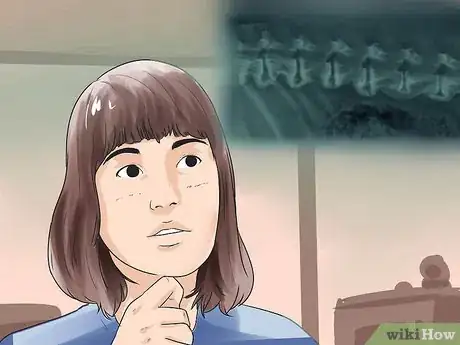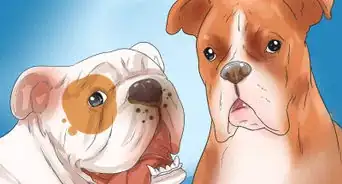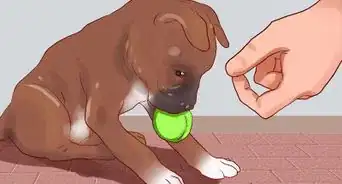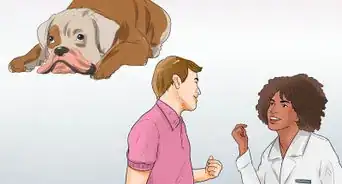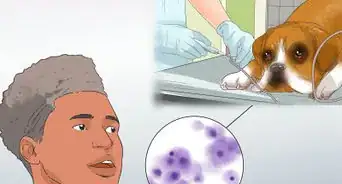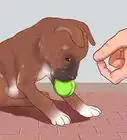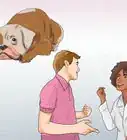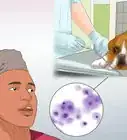This article was co-authored by Pippa Elliott, MRCVS. Dr. Elliott, BVMS, MRCVS is a veterinarian with over 30 years of experience in veterinary surgery and companion animal practice. She graduated from the University of Glasgow in 1987 with a degree in veterinary medicine and surgery. She has worked at the same animal clinic in her hometown for over 20 years.
This article has been viewed 25,651 times.
Spondylosis deformans is a condition that affects the backbone of a dog. Basically, it is when bony spurs develop on the vertebrae of older dogs and this links the vertebrae together.[1] It is a common condition, and indeed clinicians believe that all dogs will eventually develop spondylosis deformans if they live long enough. Any breed of dog can potentially be affected, although Boxers seem predisposed more than most other breeds.[2] The good news is that this condition is rarely serious, and is usually detected on x-rays while the dog is being radiographed for another reason.
Steps
Looking For the Signs of Spandylosis Deformans
-
1Pay attention to stiffness in your dog. Is your dog less agile than is used to be? If your dog has a less mobility and is reluctant to move, it may be due to this disease. This is because the spine has become fused with bone, making the dog more stiff and less flexible than it was in earlier life.[3]
- Happily, it rarely produces symptoms other than stiffness and is most often detected when the dog is x-rayed for another reason.
-
2Look for the symptoms in older dogs. This is a condition that arises as a result of the ageing process.[4] Because of this, it is not a disease to look for in younger dogs.
- Older dogs often have a variety of mobility issues, stemming from a wide array of issues related to aging. So, if your dog is having trouble moving, it could be caused by spondylosis deformans or by another disease, such as arthritis.
Advertisement -
3Take signs of discomfort seriously. Occasionally the bony bridges of spondylosis deformans can pinch the spinal nerves as they leave the spinal cord and exit between the vertebra.[5] If this is the case, the dog may yelp, whine, or shows signs of discomfort when it moves in a certain way.
- If the disease has progressed to this stage it has become a quality of life issue and needs to be addressed with veterinary care.
Getting a Veterinary Diagnosis
-
1Take your dog to the veterinarian. Any dog that is lame or shows signs of discomfort, such as restlessness, whining, or even out-of-character aggression, should be checked by a vet. This will allow the vet to find the source of the pain and to treat it.
- Your veterinarian will have to rule out many possible causes for stiffness and discomfort, spondylosis deformans is just one of them.[6] For example, older dogs often have arthritis and may be lame or stiff for this reason. This is where confusion comes in because it can be difficult to know how much a dog's lack of mobility is due to arthritis in the hips or elbows, and how much is because of spondylosis deformans.
- Your vet will take x-rays of your dog's spine to determine whether it has spondylosis deformans. Taking x-rays will also help your vet rule out other issues, like bone cancer.
-
2Discuss the disease with your veterinarian. If the condition was found incidentally, for instance because you Boxer was getting x-rays for another reason, then the condition may have no impact on your dog. Discuss how advanced the spinal growths are and what, if any, impact it will have on your dog's movement.[7]
- It is good to know about the condition before it impacts your dog's health. If you know you should be on the look out for discomfort and stiffness, it will allow you to get further veterinary help right when these symptoms appear.
-
3Follow your veterinarian's suggestions for treatment. In most cases, the only treatment given for this condition is to address symptoms of pain or discomfort. If the dog is in discomfort, then pain relief, such as a non-steroidal anti-inflammatory, may be prescribed.
- If the pain seems to be neurological in origin (such as pinched nerve roots) then gabapentin may be prescribed, as this is more effective at treating nerve-induced discomfort.
- While surgery is usually not an option, the process of laying down extra bone to stabilize the spine or removing the bony growths has been argued to be beneficial in extreme cases.[8] However, dogs with this condition tend to be old and may not recover as well from surgery as a younger dog would.
-
4Learn about how the spine works and how spondylosis deformans can affect it. This will allow you to better understand your dog's condition. The spinal cord is made up of multiple independent small bones, called vertebrae, which are arranged end to end and joined by ligaments and tendons. Between each vertebra is a cushion like disc, which allows the spine to bend and flex, while maintaining its rod-like shape.[9]
- What's thought to happen with spondylosis deformans is that as the discs slowly degenerate, extra bone is produced by the vertebra in order to bridge the gap and stabilize the spinal cord. The bridge forms between neighboring vertebrae, but as many bridges can form as necessary to stabilize the spine.[10]
- It is common to find areas of the spine affected, rather than the whole vertebrae. Common areas include the junction between the end of the thoracic (chest) spine and the beginning of the lumbar (abdomen) vertebra, or another common site is the end of the lumbar (abdomen) vertebra and the sacrum (the fused vertebrae that are attached to the pelvis).
References
- ↑ http://www.merckvetmanual.com/mvm/nervous_system/diseases_of_the_spinal_column_and_cord/degenerative_diseases_of_the_spinal_column_and_cord.html
- ↑ http://www.vetstreet.com/care/spondylosis-deformans
- ↑ http://www.merckvetmanual.com/mvm/nervous_system/diseases_of_the_spinal_column_and_cord/degenerative_diseases_of_the_spinal_column_and_cord.html
- ↑ http://www.merckvetmanual.com/mvm/nervous_system/diseases_of_the_spinal_column_and_cord/degenerative_diseases_of_the_spinal_column_and_cord.html
- ↑ http://www.mayfieldclinic.com/PE-STEN.htm
- ↑ http://www.merckvetmanual.com/mvm/nervous_system/diseases_of_the_spinal_column_and_cord/degenerative_diseases_of_the_spinal_column_and_cord.html
- ↑ http://www.vcahospitals.com/main/pet-health-information/article/animal-health/spondylosis-deformans-in-dogs/2141
- ↑ http://www.vcahospitals.com/main/pet-health-information/article/animal-health/spondylosis-deformans-in-dogs/2141
- ↑ http://www.vcahospitals.com/main/pet-health-information/article/animal-health/spondylosis-deformans-in-dogs/2141
